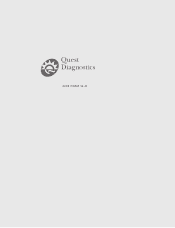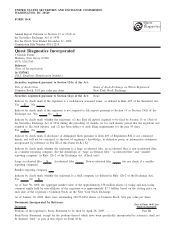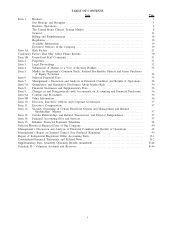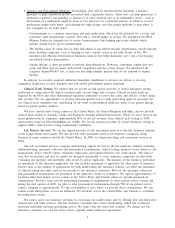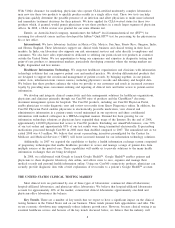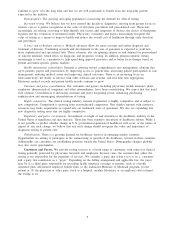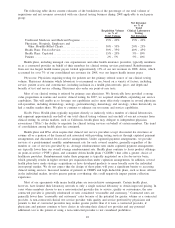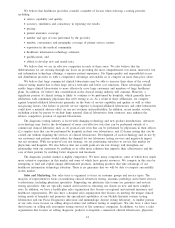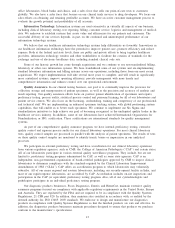Quest Diagnostics 2008 Annual Report Download - page 17
Download and view the complete annual report
Please find page 17 of the 2008 Quest Diagnostics annual report below. You can navigate through the pages in the report by either clicking on the pages listed below, or by using the keyword search tool below to find specific information within the annual report.
biotechnology firms, as well as through collaborations with emerging medical technology companies that develop
and commercialize novel diagnostics, pharmaceutical and device technologies. We search for new opportunities
and continue to build a robust pipeline of new tests in screening, diagnosis, prognosis and treatment choice,
which assists in early detection of diseases and may reduce healthcare costs. Through our strengths in assay
development, distribution and commercialization, we believe that we are the best partner for developers of new
technologies and tests to introduce their products to the marketplace.
We focus our resources on key disease states and technologies to help doctors care for their patients through
better screening, monitoring, diagnosis, prognosis and treatment choices. We also look for tests that are less
invasive than currently available options. With these priorities in mind, in 2008, we introduced a number of new
tests. A representative sampling of recent new tests is set forth below.
•Oncology.
- We expanded to 22 our growing menu of plasma-based Leumetatests. These tests are useful in
determining many different types of hematological disorders, and in particular, use qualitative findings to
assist in the diagnosis of certain hematological disorders in patients who lack the JAK2 mutation.
Plasma-based assays are an effective and less invasive way of diagnosing and monitoring leukemia and
lymphoma patients and allows for more frequent disease progression monitoring, compared to other
laboratory diagnostic methods that require patients to undergo painful procedures, such as bone marrow
biopsies.
- We introduced KRAS Mutation Analysis, a molecular test that helps to determine if patients with
metastatic colorectal or lung cancer are eligible for treatment with EGFR-targeted therapy.
- We introduced HE4, a new serum-based test exclusively licensed from Fujirebio. HE4 is the first test in
the last 20 years to receive clearance from the U.S. Food and Drug Administration (“FDA”) for
monitoring woman with ovarian cancer. This test provides valuable information in determining patient
prognosis and is selected in certain instances by physicians who traditionally order the CA125 test for
monitoring.
- We introduced InScapeVirtual Pathology which is a novel Immunohistochemistry (IHC) that allows
pathologists to access their cases through a secured HIPAA compliant website. This supports a
pathologist’s ability to remotely review stained slides and provide information back to treating
physicians more quickly and reduce the anxious waiting time of patients.
- We licensed the Septin 9 biomarker. Methylation of the Septin 9 gene is a marker in blood plasma of
colorectal cancer patients. We plan to develop plasma-based colorectal cancer screening tests using the
Septin 9 marker to act as a supplement to conventional methods of colorectal cancer screening,
including colonoscopy and fecal occult blood tests. Too often, patients fail to undergo a colonoscopy or
conduct other types of colorectal cancer screenings because they find these methods invasive, unpleasant
or costly. A blood test for detecting colorectal cancer, once developed, will be a convenient option that
complements other screening methods.
- We also licensed and are developing additional oncology applications for our ClariSureCGH
(Comparative Genomic Hybridization) Assay.
•Urology.
- We acquired exclusive rights to and launched the UroRiskDiagnostics Profile and the StoneRisk
Diagnostics Profile. These tests are considered to be the gold standard for kidney stone risk assessment
and monitoring of recurrence and help determine lifestyle changes needed to avoid further stone
development.
•Infectious Disease.
- We continued to expand our menu of tests focused on esoteric infectious diseases, drawing on our
expertise and strength in this field. Our Focus Diagnostics subsidiary was the first CLIA-approved
service laboratory in the United States to develop and introduce a test for detecting the mosquito-borne
Chikungunya virus. Commercial availability of this molecular polymerase chain reaction (PCR) test
enables physicians to test patients who may have contracted the virus while traveling to endemic areas.
- We also introduced a PCR-based test which detects virtually all known enterovirus strains, along with
multiple parecho virus strains that cause infections that can be especially severe in infants and young
children.
5


